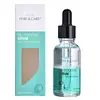What's inside
What's inside
 Key Ingredients
Key Ingredients

 Benefits
Benefits

 Concerns
Concerns

No concerns
 Ingredients Side-by-side
Ingredients Side-by-side

Water
Skin ConditioningCaprylic/Capric Triglyceride
MaskingHelianthus Annuus Seed Oil
EmollientSimmondsia Chinensis Seed Oil
EmollientButyrospermum Parkii Oil
EmollientGlycerin
HumectantPropylene Glycol
HumectantSqualane
EmollientPanthenol
Skin Conditioning3-O-Ethyl Ascorbic Acid
Skin ConditioningTocopheryl Acetate
AntioxidantButylene Glycol
HumectantSaccharide Isomerate
HumectantSodium Hyaluronate
HumectantXylitylglucoside
HumectantAnhydroxylitol
HumectantHexylene Glycol
EmulsifyingPhenoxyethanol
PreservativeOlea Europaea Oil Unsaponifiables
Skin ConditioningXylitol
HumectantRubus Chamaemorus Seed Extract
Skin ConditioningPolygonum Cuspidatum Root Extract
AntioxidantHydroxyethylcellulose
Emulsion StabilisingCentella Asiatica Extract
CleansingCamellia Sinensis Leaf Extract
AntimicrobialChamomilla Recutita Flower Extract
MaskingGlycyrrhiza Glabra Root Extract
BleachingRosmarinus Officinalis Leaf Extract
AntimicrobialScutellaria Baicalensis Root Extract
AstringentCitric Acid
BufferingSodium Citrate
BufferingCI 42090
Cosmetic ColorantSodium Hydroxide
BufferingCI 19140
Cosmetic ColorantEthylhexylglycerin
Skin ConditioningCellulose Gum
Emulsion StabilisingWater, Caprylic/Capric Triglyceride, Helianthus Annuus Seed Oil, Simmondsia Chinensis Seed Oil, Butyrospermum Parkii Oil, Glycerin, Propylene Glycol, Squalane, Panthenol, 3-O-Ethyl Ascorbic Acid, Tocopheryl Acetate, Butylene Glycol, Saccharide Isomerate, Sodium Hyaluronate, Xylitylglucoside, Anhydroxylitol, Hexylene Glycol, Phenoxyethanol, Olea Europaea Oil Unsaponifiables, Xylitol, Rubus Chamaemorus Seed Extract, Polygonum Cuspidatum Root Extract, Hydroxyethylcellulose, Centella Asiatica Extract, Camellia Sinensis Leaf Extract, Chamomilla Recutita Flower Extract, Glycyrrhiza Glabra Root Extract, Rosmarinus Officinalis Leaf Extract, Scutellaria Baicalensis Root Extract, Citric Acid, Sodium Citrate, CI 42090, Sodium Hydroxide, CI 19140, Ethylhexylglycerin, Cellulose Gum
Water
Skin ConditioningButylene Glycol
HumectantHydrolyzed Collagen
EmollientCorn Gluten Amino Acids
Skin ConditioningDipropylene Glycol
HumectantPhenoxyethanol
PreservativeSodium Hyaluronate
HumectantMorus Alba Root Extract
BleachingSodium Polyacrylate
AbsorbentSilk Extract
Skin ConditioningGlycosphingolipids
EmollientPortulaca Oleracea Extract
Skin ConditioningEuglena Gracilis Polysaccharide
Gel FormingGlycerin
HumectantPotassium Sorbate
PreservativeHexylene Glycol
EmulsifyingPropanediol
SolventBeta-Glucan
Skin ConditioningOpuntia Ficus-Indica Extract
Skin ConditioningEthylhexylglycerin
Skin ConditioningWater, Butylene Glycol, Hydrolyzed Collagen, Corn Gluten Amino Acids, Dipropylene Glycol, Phenoxyethanol, Sodium Hyaluronate, Morus Alba Root Extract, Sodium Polyacrylate, Silk Extract, Glycosphingolipids, Portulaca Oleracea Extract, Euglena Gracilis Polysaccharide, Glycerin, Potassium Sorbate, Hexylene Glycol, Propanediol, Beta-Glucan, Opuntia Ficus-Indica Extract, Ethylhexylglycerin
Ingredients Explained
These ingredients are found in both products.
Ingredients higher up in an ingredient list are typically present in a larger amount.
Butylene Glycol (or BG) is used within cosmetic products for a few different reasons:
Overall, Butylene Glycol is a safe and well-rounded ingredient that works well with other ingredients.
Though this ingredient works well with most skin types, some people with sensitive skin may experience a reaction such as allergic rashes, closed comedones, or itchiness.
Learn more about Butylene GlycolEthylhexylglycerin (we can't pronounce this either) is commonly used as a preservative and skin softener. It is derived from glyceryl.
You might see Ethylhexylglycerin often paired with other preservatives such as phenoxyethanol. Ethylhexylglycerin has been found to increase the effectiveness of these other preservatives.
Glycerin is already naturally found in your skin. It helps moisturize and protect your skin.
A study from 2016 found glycerin to be more effective as a humectant than AHAs and hyaluronic acid.
As a humectant, it helps the skin stay hydrated by pulling moisture to your skin. The low molecular weight of glycerin allows it to pull moisture into the deeper layers of your skin.
Hydrated skin improves your skin barrier; Your skin barrier helps protect against irritants and bacteria.
Glycerin has also been found to have antimicrobial and antiviral properties. Due to these properties, glycerin is often used in wound and burn treatments.
In cosmetics, glycerin is usually derived from plants such as soybean or palm. However, it can also be sourced from animals, such as tallow or animal fat.
This ingredient is organic, colorless, odorless, and non-toxic.
Glycerin is the name for this ingredient in American English. British English uses Glycerol/Glycerine.
Learn more about GlycerinHexylene Glycol is a surfactant. Glycols are a class of alcohols. Hexylene Glycol is a surfactant and emulsifier.
As a surfactant, Hexylene Glycol helps gather dirt and oil on your skin to be washed away.
As an emulsifier, Hexylene Glycol helps keep water and oil together. This prevents them from separating in a product. Hexylene Glycol also thins out the texture of a product by lessening viscosity.
Hexylene Glycol has a small molecular weight.
Learn more about Hexylene GlycolPhenoxyethanol is a preservative that has germicide, antimicrobial, and aromatic properties. Studies show that phenoxyethanol can prevent microbial growth. By itself, it has a scent that is similar to that of a rose.
It's often used in formulations along with Caprylyl Glycol to preserve the shelf life of products.
Sodium Hyaluronate is hyaluronic acid's salt form. It is commonly derived from the sodium salt of hyaluronic acid.
Like hyaluronic acid, it is great at holding water and acts as a humectant. This makes it a great skin hydrating ingredient.
Sodium Hyaluronate is naturally occurring in our bodies and is mostly found in eye fluid and joints.
These are some other common types of Hyaluronic Acid:
Learn more about Sodium HyaluronateWater. It's the most common cosmetic ingredient of all. You'll usually see it at the top of ingredient lists, meaning that it makes up the largest part of the product.
So why is it so popular? Water most often acts as a solvent - this means that it helps dissolve other ingredients into the formulation.
You'll also recognize water as that liquid we all need to stay alive. If you see this, drink a glass of water. Stay hydrated!
Learn more about Water